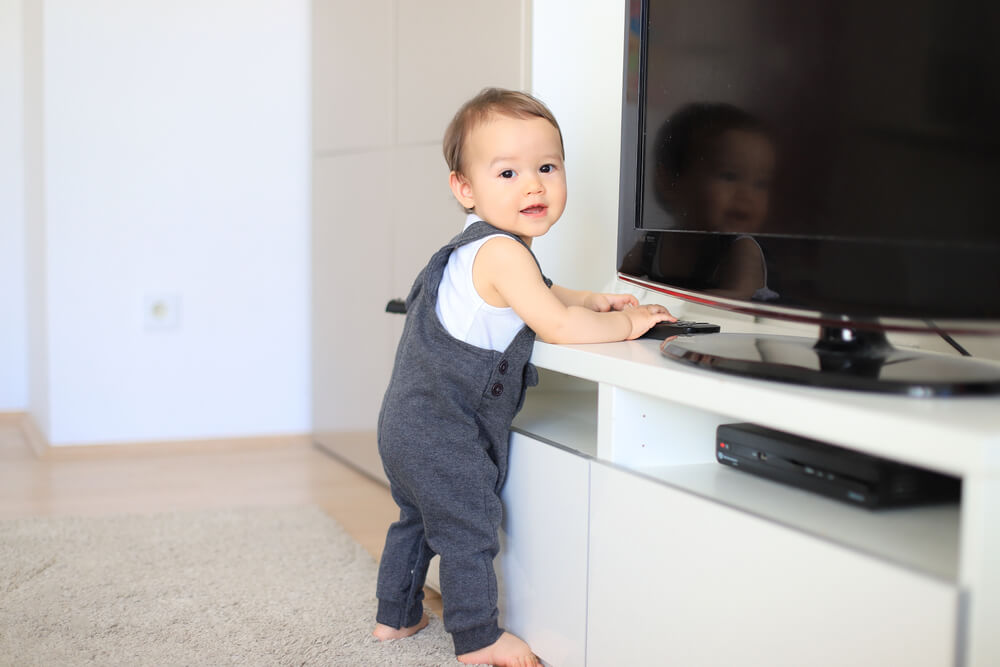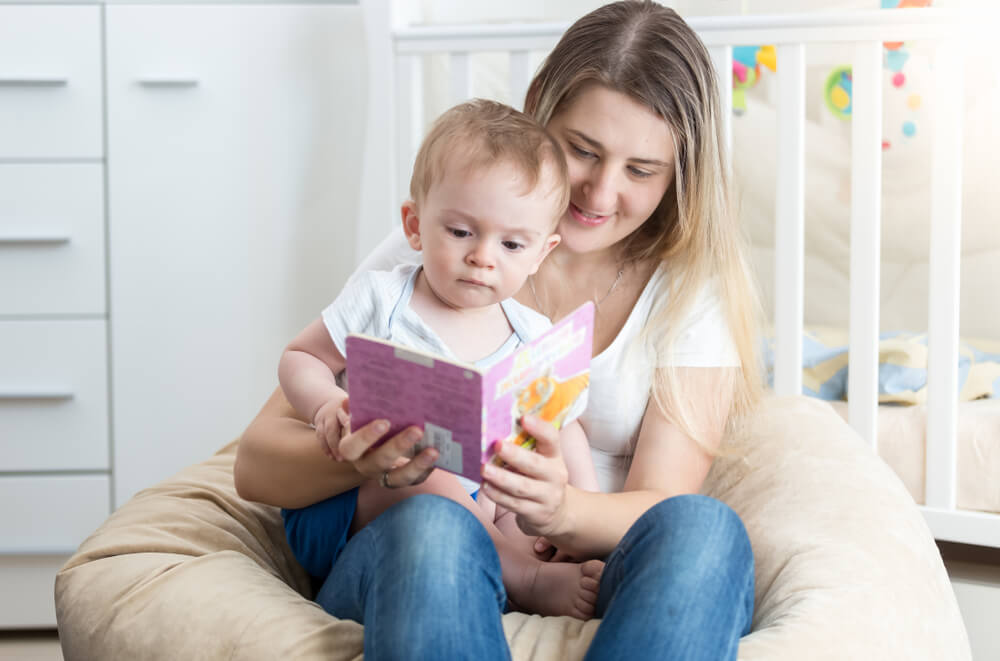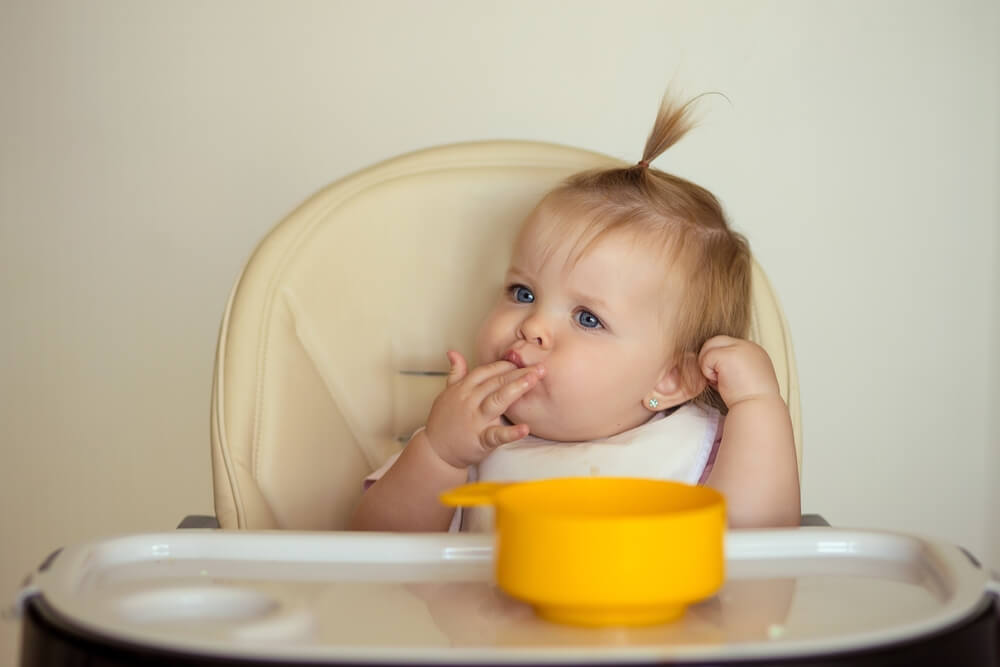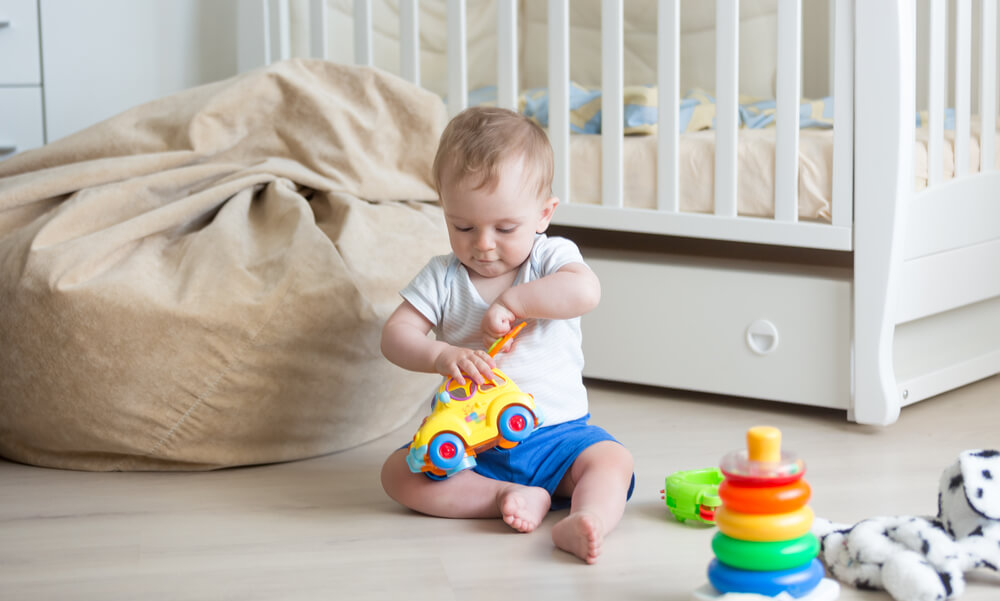What Can a 10-Month-Old Baby Do?

10 months is a big stage of a baby’s development. It’s around this time that little ones start to become increasingly active, crawling around and exploring the home. Read on through our guide to find out all you need to know about your 10-month-old, including important milestones and health tips.
Contents:
- Physical Development
- What Should a Child Do at 10 Months?
- 10-Month-Old Baby Schedule
- Activities for a 10-Month-Old Baby
- Typical Diseases, Remedies and Health Concerns
- Helping Baby Development
- FAQ
Physical Development

Onjira Leibe/Shutterstock.com
Let’s begin with a look at the physical characteristics of the average 10-month-old baby, as babies tend to start developing quite quickly at this age and look very different to the tiny newborn you brought home from the hospital.
In fact, 10 month old babies usually weigh more than double what they weighed at the time of birth. They’re also a lot stronger and more physically capable, able to pull themselves up and crawl around a lot.
Every baby is different, so there’s no need to worry too much about comparing your child to others too closely at this stage. Some 10 month olds can be quite chubby, for example, but others actually lose a little weight at this stage as they become more active and less interested in some foods.
In terms of height and weight, average heights are approximately 28.8 inches for boys and 28.2 inches for girls, while the average weight for a 10-month-old girl is close to 19 lbs and boys tend to tip the scales at a little over 20 lbs. At this age, both boys and girls have size 4 shoes, on average.
What Should a Child Do at 10 Months?

noBorders – Brayden Howie/Shutterstock.com
Next, let’s look at some of the most important milestones at this age, including emotional milestones, social changes, and movement milestones for your little one. Remember, every baby is different, so don’t worry if your child hasn’t quite reached all of these milestones just yet.
Emotional Milestones
In terms of emotional milestones, one thing that you may notice at this age is that your baby becomes quite clingy and attached to either one or both of its parents. They may also show signs of fear or anxiety when strangers are around.
Babies at this age may also show signs of distress if a parent leaves the room or home for a while. This is perfectly normal, and it’s part of a phase that almost all babies go through called “separation anxiety”.
Dealing with separation anxiety can be hard, but it should become less intense after a few months. You may also notice that your little one becomes very attached to certain items, like a favorite toy or teddy bear that they like to keep with them at all times. Again, this is totally normal.
Language Milestones
In terms of language and communication, your baby might not yet be able to say any real words, but their language skills are still developing in some major ways, and you may notice them trying to imitate words and speech patterns of people around them.
At this age, babies often try to copy sounds they hear. They might use certain gestures to communicate, like waving to people to say goodbye or shaking their head to say “no” when they don’t want something.
10-month-old children also may start using other signs to communicate, like pointing at things, and they may show signs of understanding basic questions. For example, if you ask “Where is your mommy?” the baby may point at their mother.
Cognitive Milestones

kryzhov/Shutterstock.com
At this age, your baby’s brain is developing at a rapid pace. They’re learning more and more each day, like little sponges soaking up information from the world around them, with many new brain cells forming all the time, too.
At this age, it’s normal for babies to develop a better understanding of object permanence. This means that they’ll be able to find where things are, even when they’re out of sight. For example, if you hide a teddy bear behind the sofa, the baby will know where it is and crawl around to get it.
Babies at this age also tend to have improved levels of hand-eye coordination. This means that they can grab onto things, like pieces of food, without easily dropping them. And this opens the door to lots of new games and activities as you little one will be able to play with more toys and games.
Movement Milestones
Finally, there are the movement milestones, and this is another area in which your little one should be showing signs of rapid development. For example, they should be crawling around the home more than ever before.
Most babies at this age tend to be very active and curious, so they’ll crawl all over the place and explore their surroundings energetically. They may also be able to pull themselves along in the future and lift themselves to a standing position.
You should notice your little one picking things up more regularly, too, and crawling around to find items in different areas. They might even be able to take their first few steps, although this tends to happen a little later on in their development.
10-Month-Old Baby Schedule

Yulia Prizova/Shutterstock.com
As your baby continues to grow, it’s important for you to adapt their schedule accordingly in order to meet their ever-changing needs. And when it comes to 10-month-olds, the average feeding and sleeping schedule is a little different to what it once was a few months earlier on.
Feeding
In terms of feeding, 10-month-old babies should have a mixture of solid foods as their teeth are developing, as well as continuing with breast milk and formula. Here are some example feeding schedules.
Formula
If your baby is on formula, you’ll need to feed them around 6-8oz of formula four times a day, resulting in about 32 oz of formula every 24 hours. They’ll also need around 800-950 kcal worth of food, and some good foods to use are soft fruits, cereals, cooked veggies, well-cooked meat, and dairy.
Breastfed
For breastfed babies, it is more or less the same. Aim for around three or four nursing sessions daily, with anywhere from 24 to 32 oz of breastmilk in each 24 hour period. The rest of your baby’s diet can be made up of the foods listed above.
Sleeping
At this age, babies tend to get around 10 to 12 hours of sleep each night and will have another couple of naps during the day of around 1-2 hours each, resulting in a total amount of 12 to 16 hours of sleep daily. This should be quite similar to the 9 month stage, and your baby should have got into a good sleeping rhythm by this point.
Exercise and Activities
Since babies tend to become more active and curious at this age, it’s a great time to try and fit in as many games and activities as you can throughout the day. Whenever you get some time in between naps and eating, try to have some quality bonding time with your little one and enjoy some fun activities like reading books and playing games.
Activities for a 10-Month-Old Baby

kryzhov/Shutterstock.com
There are lots of fun and interesting activities you can try with your 10-month-old to keep them entertained and aid in their development, too.
Games
Here are a few examples of games to play with a little one at the age of 10 months:
- Peek-a-boo — Babies love this adorable game where you hide behind an object or your hands and then peek out at random.
- Pat-a-cake — 10-month-old babies also enjoy playing pat-a-cake and will happily sing along in their own little words as you tap your hands together.
- Singing — Kids at 10-month-old tend to enjoy music and singing, so they’ll have a lot of fun dancing and singing with you if you play some music in the background.
- Sorting — This is a fun way to improve your child’s hand-eye coordination and problem-solving abilities. Try to put items, like toys or building blocks, in piles according to their color and encourage your child to do the same.
Toys
There are also plenty of great toys that are suitable for 10-month-old children. Here are some examples:
- Blocks — Babies love building blocks, and 10 months is a good age to start playing around with blocks as your baby gets better at holding onto things.
- Push and Pull — Babies at this age also really enjoy push and pull toys, like little cars that make sounds as you push them along the floor.
- Bath Toys — Bath time is a great time for fun and enjoyment, and there are lots of fun bath toys you can get for your little one like little plastic slides and fish to swim around in the water.
More
Here are a few more ideas of activities to try out with your 10-month-old child:
- Reading — Your baby won’t be able to read on their own just yet, but you can read simple books to them and show them the words and pictures.
- Chatting — Just chatting to your baby is a great way to help them learn lots of new words and encourage them to imitate your speech.
- Art — At 10 months of age, many babies are also able to hold onto crayons and start drawing or coloring their own pictures.
Typical Diseases, Remedies and Health Concerns

LStockStudio/Shutterstock.com
So, are there any major health concerns to be aware of when your baby reaches 10 months of age? Well, there aren’t too many diseases or common health problems that strike at this age, but there are some new risks to be aware of.
Since your baby is becoming more mobile, crawling around more and exploring the world around them, you really need to keep a close eye on them to avoid any accidents or injuries.
For example, a crawling baby can make its way into the kitchen and start sniffing around at your dog’s food, for example, or poke its fingers into a power outlet. They could also investigate open drawers and cabinets and could find some harmful chemicals, if you’re not careful.
Parents should make sure that outlets are covered and dangerous items are hidden up high, out of baby’s reach. It’s also recommended to not leave any containers of water around, including small bowls and buckets, as it only takes a small amount of water to drown a young child.
Helping Baby Development
Here are a few ways in which you can help your baby’s development at this age:
- Communicate — Talk to your baby often. Even if you’re simply describing the surroundings or telling them about your day, all the words and sounds will help them learn language faster.
- Supervise — Keep a close eye on your baby when they’re crawling around to make sure they don’t put themselves in any dangerous situations.
- Don’t Force Anything — Parents at this point may be hoping to see their baby take their first steps, but there’s no need to rush things or force it. Walkers, for example, aren’t usually safe for kids of this age, so it’s best to be patient and wait for nature to take its course.
- Play Music — Having some music on in the background is a great way to encourage your little one to move, dance, sing along, and have a fun, happy day.
FAQ

Monkey Business Images/Shutterstock.com
What Should a 10-Month-Old Be Able To Do?
Every baby is different, but most 10-month-olds can crawl, pull themselves up, sleep for long periods without waking up, and walk with someone holding their hands.
Can a 10-Month-Old Talk?
At this age, many babies can’t say many real words but might be saying “Mama” and “Dada”.
Can 10-Month-Old Babies Walk?
It’s certainly possible, but quite rare. Most babies don’t start walking until after their 1st birthday, but some do it as early as 8 months.
A Big Milestone for Baby and Parents
10 months is a big time for the whole family, and it’s very exciting to see your little one starting to move around more, becoming more confident and sure of themselves as they crawl, lift themselves up, and pick items up off the ground.
Just make sure to keep a close eye on them as they become more curious to avoid any unwanted accidents, and remember to share this guide around to help other parents with 10-month-old children, too.
The picture on the front page: Inna photographer/Shutterstock.com
Проверьте электронный ящик



















